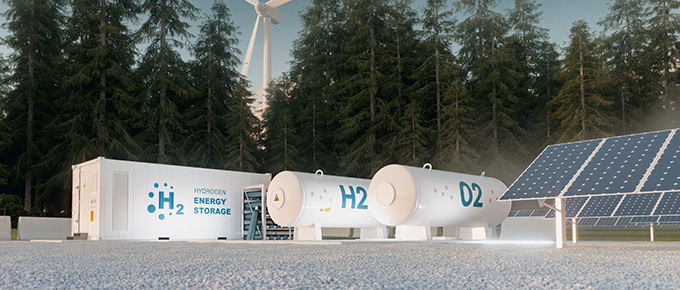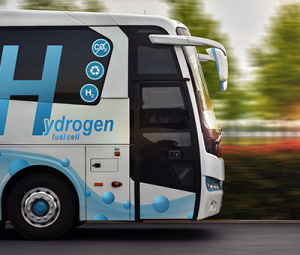Environmental challenges
Hydrogen: challenges and opportunities

A source of energy that produces no greenhouse gases, gives cars a 700-kilometre range on a single tank, and provides the power for planes to fly. Such is the promise of hydrogen, a potential that is now hard to ignore. Today, the hydrogen sector is gaining in structure and global reach, and creating the real prospect of future opportunities.
Well-known for its industrial applications, such as fertiliser manufacturing or reducing the sulphur content of crude oil, today’s interest in hydrogen is all about its potential as a fuel. After all, the same amount delivers 2.5 times as much energy as petrol, thanks to a combustion process where the only waste emission is water. All of which surely makes hydrogen the ultimate green energy source? Not so fast… Many of today’s processes for hydrogen production are actually a poor fit for the sustainability agenda.
The potential of hydrogen
Its real promise as an energy source lies in the fact that hydrogen can be used in so many ways – injected into the natural gas network, a storage solution for renewable energy and, above all, for use in fuel cells that can power electric vehicles (cars, fork-lift trucks, buses, etc.), small electrical appliances or the electricity supplies of remote areas.
The growth in hydrogen-based projects is driven by a variety of factors, according to Daniel Hissel, a professor at Franche-Comté University and deputy director of France’s research federation for hydrogen (FRH2), which is part of the National Centre for Scientific Research (CNRS). “From a technological point of view, performance has massively increased, costs have fallen and the lifetimes of hydrogen products have been extended. Fifteen years ago, hydrogen fuel cells were 30 times more expensive than they are today, 50 times less powerful for a given volume of fuel, and had a lifetime that was 50 times shorter.”
At the same time, this technological progress has been accompanied by a new societal paradigm – the state of the environment. “Concerns about societal and environmental issues are forcing us to take carbon out of the mobility equation, and hydrogen is one way of doing that. At last, politicians are dealing with these issues and realising that this sector provides not only an answer to the industrial, economic and environmental issues we face, but is also an opportunity to return to local fuel production.”
A global trend
To make room for hydrogen in the future energy mix, investments are being made by national governments and industrial companies alike. In September 2020, France announced a €7.2 billion plan to become a major player in the sector by 2030, and is far from being the first country to reveal such an objective. In recent years, other countries have also placed huge bets on hydrogen as an energy source, creating new competency hubs.
 One example is China, which has set itself ambitious targets for promoting hydrogen-powered vehicles, aiming to have more than a million on the roads by 2028. “Mobility is a major problem for China, given the explosive growth in car ownership and the extremely high levels of pollution in its mega-cities. For heavy vehicles like lorries, battery power is simply not a realistic option,” says Daniel Hissel. “Hydrogen is THE solution.” Japan, another leading player in the sector, sees hydrogen as a way of disengaging from the nuclear industry. “Japan has the world’s highest number of fuel cells installed in residential properties for co-generating electricity and heating.”
One example is China, which has set itself ambitious targets for promoting hydrogen-powered vehicles, aiming to have more than a million on the roads by 2028. “Mobility is a major problem for China, given the explosive growth in car ownership and the extremely high levels of pollution in its mega-cities. For heavy vehicles like lorries, battery power is simply not a realistic option,” says Daniel Hissel. “Hydrogen is THE solution.” Japan, another leading player in the sector, sees hydrogen as a way of disengaging from the nuclear industry. “Japan has the world’s highest number of fuel cells installed in residential properties for co-generating electricity and heating.”
Europe is also backing hydrogen for its decarbonisation strategy, with the take-up being led by France, Germany, Norway and Portugal. A delighted Daniel Hissel commented: “2020 was the year of hydrogen in Europe, thanks to the clear, practical commitments made at both national and EU levels. It sends a strong signal to industrial companies and the research community. Every industrial group is now looking at the potential of this energy source.”
A major challenge: decarbonising hydrogen
Technological progress, environmental awareness, the backing needed by private and public players… everything looks to be in place for hydrogen to prove itself as a sustainable, responsible fuel. However, there are still a number of issues to be resolved before it can properly develop, including the problems of storage and, even more importantly, of production. Hydrogen might be 90% of the total mass of the universe, but it is almost non-existent at a molecular level on Earth and has to be extracted from other components, usually hydrocarbons. “Today, hydrogen production is neither green nor clean: 95% of it comes from fossil resources,” highlights Daniel Hissel. “However, French and other European programmes are aiming to produce it from renewable energy or decarbonised sources, creating what’s known as ‘green hydrogen’ or ‘blue hydrogen.’
One of the possible solutions is to improve the electrolysis process (where hydrogen is extracted from water) by using a high temperature environment, which lowers the production cost of carbon-free hydrogen.
Supporting the industry’s development through training
Another way of encouraging hydrogen development is to create a genuine ecosystem that brings together nation states, regional authorities, researchers and industrial companies. As Daniel Hissel points out: “There is a highly-developed network of SMEs, start-ups and research laboratories in France, all working on hydrogen. They are the ones providing the disruptive innovations and ideas, while the major corporations are providing the financial and operational resources.” Similar networks are being created in Germany and other countries in northern Europe. Germany, which in June 2020 announced a €9 billion plan to become the world’s No. 1 in hydrogen1/2, is backing its potential as an alternative to nuclear energy, and as a way of storing renewable energy.
Training will have an essential role to play in all this, given the expected creation, in France for example, of tens of thousands of jobs, both directly and indirectly, by 2030, with estimates ranging from 58,000 to 107,000. Underlining its importance, Daniel Hissel said: “For the hydrogen industry to grow, it will need trained labourers, technicians and engineers, and this training element will need to be there on a local basis at every level (PhD, Masters, degree, vocational training, part-time study, etc.)
“Hydrogen’s share of the energy mix is naturally going to increase,” he adds. “The rate of that increase will depend on the cost of providing it, and in particular carbon-free hydrogen. By increasing the number of potential applications, the price will tend to drift downwards due to massive industrial-scale production.” At that stage, hydrogen will certainly be playing its part in the energy transition.
